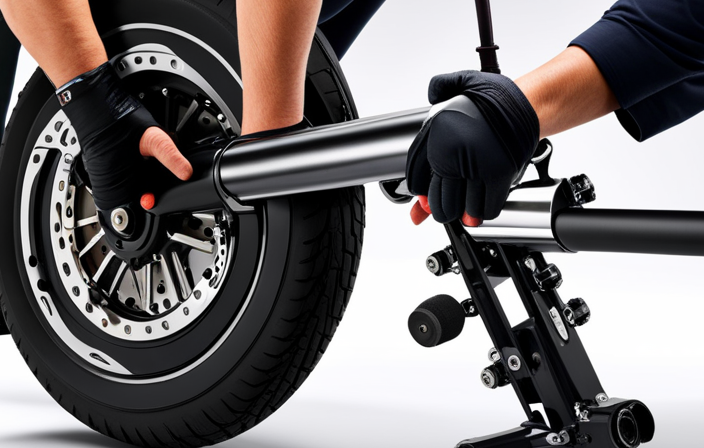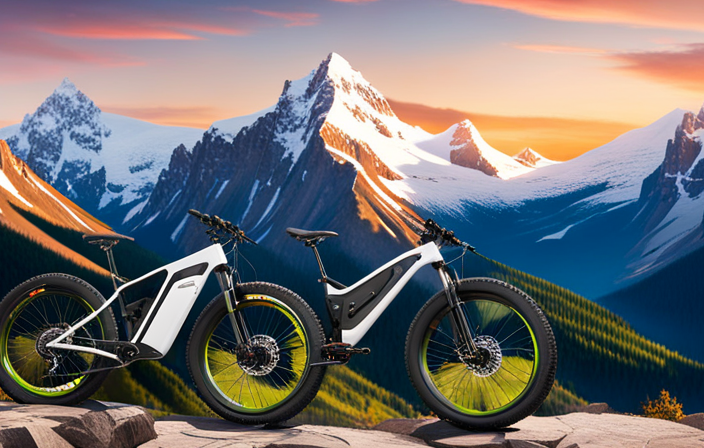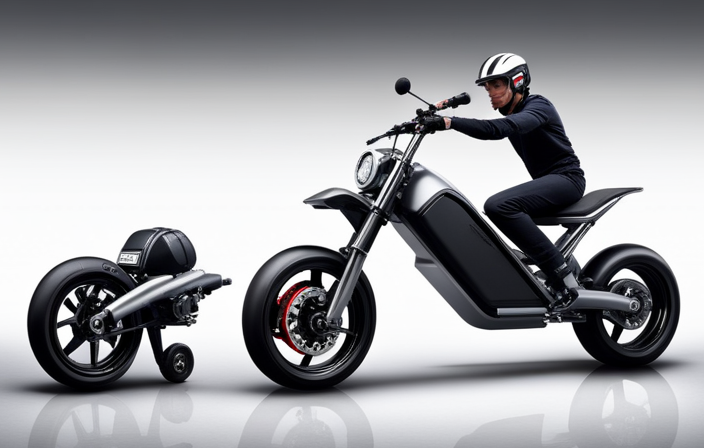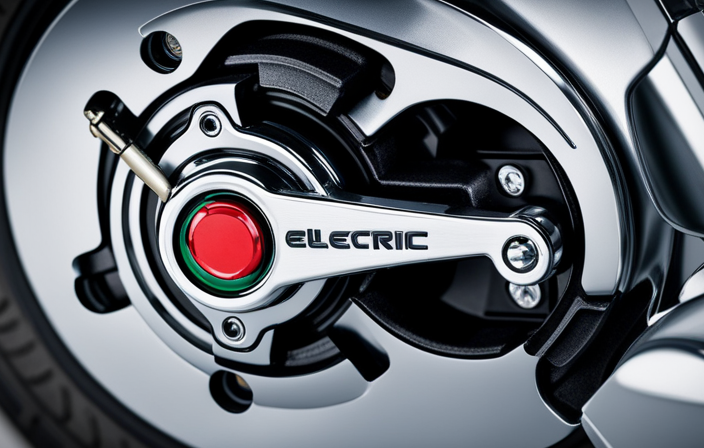Hello there, everyone! Are you prepared to roll up your sleeves and learn about electric bike motor upkeep? You’re in the right spot!
In this step-by-step guide, I’ll walk you through the process of servicing your rear wheel electric bike motor. From understanding the basics to troubleshooting any issues, we’ve got you covered.
So, let’s strap on our tool belts and get ready to revamp that motor!
Key Takeaways
- Regularly inspect the motor housing for damage or wear
- Troubleshoot internal gears and bearings if noise persists
- Ensure clean and secure battery connections, and test battery voltage with a multimeter
- Seek professional help from experts specializing in electric bike repairs
Basic Understanding of Electric Bike Motors
Before we dive into servicing the rear wheel electric bike motor, let’s start with a basic understanding of how these motors work.
Electric bike motors are designed to provide power and assistance to the rider while pedaling. They operate on the principle of electromagnetic induction, where a magnetic field is created by passing an electric current through a coil of wire. This magnetic field interacts with permanent magnets to create rotational motion, which is transmitted to the rear wheel to propel the bike forward.
To ensure optimal performance and longevity of the motor, regular maintenance is essential. This includes cleaning, lubricating, and inspecting the motor for any signs of wear or damage. Troubleshooting common motor issues such as overheating or loss of power is also important.
Now that we understand the basics of electric bike motors, let’s move on to discussing the tools and equipment needed for servicing.
Tools and Equipment Needed for Servicing
You’ll need a few tools and equipment to properly maintain your rear wheel electric bike motor. Here’s a checklist of what you’ll need:
- Wrench set: This will help you loosen and tighten bolts and screws on the motor and other components.
- Torque wrench: This tool ensures that you tighten bolts to the manufacturer’s recommended torque specification, preventing over-tightening or under-tightening.
- Multimeter: This device allows you to measure voltage, current, and resistance, helping you troubleshoot electrical issues.
Having these tools on hand will make servicing your rear wheel electric bike motor much easier.
Now that you have the necessary tools, let’s move on to preparing the bike for maintenance.
Preparing the Bike for Maintenance
To get started, make sure you’ve gathered all the necessary tools and equipment for the maintenance. Before checking and cleaning the motor of your rear wheel electric bike, it’s important to prepare the bike for maintenance.
Here are the steps to follow:
-
Begin by thoroughly cleaning the bicycle. Use a mild detergent and water to remove any dirt, grime, or grease from the frame, wheels, and other components. Pay special attention to the areas around the motor.
-
Once the bike is clean, dry it thoroughly to prevent any water damage. Use a soft cloth or towel to remove excess moisture.
-
Next, ensure that the bike is stored in a dry and secure location. Proper storage is crucial to prevent any damage or corrosion to the motor and other parts of the bike.
Checking and Cleaning the Motor
Now that the bike is properly prepared, it’s time to check and clean the motor to ensure optimal performance. Motor troubleshooting and maintenance are essential to keep your electric bike running smoothly. Follow these steps to properly inspect and clean the motor:
- Start by visually inspecting the motor for any signs of damage or loose connections.
- Use a multimeter to test the electrical connections and make sure they are secure.
- Remove the motor cover and inspect the brushes for wear. If they are worn out, replace them.
- Clean the motor casing and fan blades using a soft brush or compressed air to remove any dirt or debris.
- Inspect the motor bearings for any signs of wear or damage. If necessary, lubricate them with a small amount of motor oil.
By properly checking and cleaning the motor, you can ensure its optimal performance and extend its lifespan.
Now, let’s move on to lubricating the moving parts of the bike.
Lubricating Moving Parts
Properly lubricating the moving parts is crucial for ensuring smooth operation and reducing wear and tear on your e-bike. Regular maintenance is important to keep your electric bike running smoothly and efficiently.
When it comes to lubricating the moving parts, choosing the right lubricant is essential. You want to select a lubricant that is specifically designed for e-bikes and is compatible with the materials used in your bike’s components.
Before applying the lubricant, clean the parts thoroughly to remove any dirt or debris. Start by applying the lubricant to the chain, making sure to cover each link. Then, move on to the derailleur, pulleys, and other moving parts, applying a small amount of lubricant to each.
Finally, wipe off any excess lubricant and make sure all the parts are properly lubricated.
Inspecting and replacing worn components is the next step in maintaining your e-bike’s rear wheel motor.
Inspecting and Replacing Worn Components
When inspecting and replacing worn components on your e-bike, it’s important to check for any signs of damage or excessive wear. One common issue that may arise is motor noise, which can be caused by worn-out motor brushes.
To troubleshoot motor noise, follow these steps:
- Remove the motor cover to access the motor brushes.
- Inspect the brushes for any signs of wear or damage, such as fraying or uneven wear.
- If the brushes appear worn, it’s time to replace them.
- Refer to your e-bike’s manual to identify the correct replacement brushes.
- Carefully remove the old brushes and install the new ones, ensuring they are properly aligned.
- Reassemble the motor cover.
Adjusting Motor Settings and Controls
To optimize performance, it’s essential to adjust the settings and controls of the motor on your e-bike. Here are the steps to adjust your motor settings and controls:
-
Power Level Adjustment: Most e-bikes have multiple power levels to choose from. Use the control panel or display to select the desired power level. Higher levels provide more assistance but may drain your battery faster.
-
Torque Sensor Calibration: If your e-bike has a torque sensor, it’s important to calibrate it periodically. Refer to your owner’s manual for specific instructions on how to calibrate the sensor.
-
Speed Limit Adjustment: Some e-bikes have a speed limit feature, which restricts the maximum speed the motor can assist you. Adjust the speed limit according to your preference and local regulations.
-
Error Code Troubleshooting: If you encounter any error codes or common problems with your motor, consult the user manual or contact the manufacturer for troubleshooting steps.
Testing the Motor and Troubleshooting Issues
Testing and troubleshooting the motor is crucial to ensure optimal performance and address any issues that may arise. One common issue with electric bike motors is motor noise. If you hear unusual noises coming from the motor, it could indicate a problem with the internal components.
To troubleshoot motor noise, start by checking the motor mounts and bolts to ensure they are securely tightened. Next, inspect the motor housing for any signs of damage or wear. If the noise persists, it may be necessary to disassemble the motor and inspect the internal gears and bearings.
Another important aspect of motor testing is battery troubleshooting. If the motor is not receiving sufficient power from the battery, it can lead to performance issues. To troubleshoot battery problems, start by checking the battery connections to ensure they are clean and securely attached. Next, use a multimeter to test the battery voltage. If the voltage is significantly lower than the manufacturer’s specifications, it may be time to replace the battery.
Once you have completed the motor testing and troubleshooting process, it is important to establish a regular maintenance schedule to keep your electric bike in optimal condition.
Regular Maintenance Schedule
Once you’ve finished the motor testing and troubleshooting process, it’s important to establish a regular maintenance schedule to keep your e-bike running smoothly. Regular maintenance is crucial to ensure the longevity and optimal performance of your electric bike’s rear wheel motor.
Here are some key reasons why regular maintenance is important:
-
Importance of regular maintenance: Regular maintenance helps identify and address any potential issues before they escalate into major problems. It also helps extend the lifespan of your motor and ensures that it operates efficiently.
-
Common maintenance mistakes to avoid: One common mistake is neglecting routine cleaning and lubrication. Dirt and debris can accumulate on the motor, affecting its performance. Another mistake is ignoring strange noises or vibrations, which could be signs of underlying issues that need to be addressed promptly.
By following a regular maintenance schedule and avoiding these common mistakes, you can keep your e-bike’s rear wheel motor in top condition.
However, if you encounter complex problems or are unsure about any maintenance tasks, it’s always wise to seek professional help.
Seeking Professional Help
If you’re unsure about any maintenance tasks or encounter complex problems, it’s wise to seek professional assistance. When it comes to servicing a rear wheel electric bike motor, finding experts who specialize in electric bike repairs is crucial. Here are the steps to find the right professionals for the job:
-
Research: Start by researching local bike shops or electric bike dealerships that offer maintenance services specifically for electric bike motors. Look for shops that have experience and expertise in handling electric bike repairs.
-
Recommendations: Ask fellow electric bike owners or cycling enthusiasts for recommendations. They might have had positive experiences with certain professionals or shops and can provide valuable insights.
-
Reviews and Ratings: Check online platforms or forums where people share their experiences with different maintenance service providers. Look for shops that have good reviews and high ratings from customers.
-
Consultation: Once you’ve narrowed down your options, schedule consultations with the selected professionals. Discuss your specific needs and concerns regarding your rear wheel electric bike motor.
Frequently Asked Questions
Can I service the rear wheel electric bike motor without any prior mechanical experience?
Yes, you can service the rear wheel electric bike motor even without prior mechanical experience. However, to avoid common mistakes, follow these tips: 1. Familiarize yourself with the motor components. 2. Use proper tools. 3. Take it slow and be patient.
How often should I check the motor for wear and tear?
I check my rear wheel electric bike motor for wear and tear regularly, like a watchful hawk monitoring its prey. It is recommended to service the motor every 500-1000 miles to prevent common causes of wear and tear, such as dirt buildup and chain tension.
Can I use any type of lubricant for the moving parts of the motor?
I can use lubricants specifically designed for electric bike motors to ensure optimal performance. It is important to follow the manufacturer’s recommendations for lubricant options and best practices to prevent damage and extend the motor’s lifespan.
What are the signs that indicate the motor may need to be replaced?
One interesting statistic: According to a study, the average lifespan of an electric bike motor is around 20,000-30,000 miles. Signs of motor failure include overheating, loss of power, unusual noises, and excessive vibration. When these signs occur, it may be necessary to consider motor replacement.
What should I do if I encounter a problem with the motor that I cannot troubleshoot on my own?
If I encounter a problem with the motor that I cannot troubleshoot on my own, I would seek professional help. They have the expertise to diagnose and fix common motor problems efficiently and effectively.
Conclusion
To conclude, servicing a rear wheel electric bike motor is an essential task for maintaining optimal performance. By following a regular maintenance schedule and utilizing the right tools, one can ensure the longevity of their motor.
Checking and cleaning the motor, lubricating moving parts, and adjusting motor settings are all crucial steps in keeping the motor running smoothly.
Remember, if any issues arise or if you’re unsure about any step, seeking professional help is always a smart choice. So, stay savvy and keep your electric bike motor in tip-top shape!









